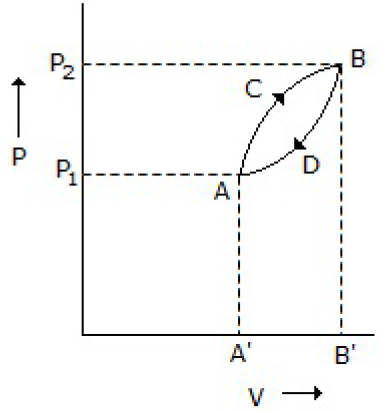Domestic refrigerator usually works on the __________ refrigeration cycle.
Carnot
Air
Absorption
vapour-ejection
Correct Answer :
C. Absorption
Related Questions
In an ideal refrigeration cycle, the change in internal energy of the fluid is
+ve
-ve
0
Either of the above three; depends on the nature of refrigerant
At 60° C, vapour pressure of methanol and water are 84.562 kPa and 19.953 kPa respectively. An aqueous solution of methanol at 60° C exerts a pressure of 39.223 kPa; the liquid phase and vapour phase mole fractions of methanol are 0.1686 and 0.5714 respectively. Activity co-efficient of methanol is
1.572
1.9398
3.389
4.238
Mollier chart is a __________ plot.
Pressure vs. enthalpy
Pressure vs. volume
Enthalpy vs. entropy
Temperature vs. entropy
Van Laar equation deals with the activity coefficients in
Binary solutions
Ternary solutions
Azeotropic mixture only
None of these
As the entropy of the universe is increasing, day by day, the work producing capacity of a heat engine is
Not changed
Decreasing
Increasing
Data sufficient, can't be predicted
The expression for entropy change, ΔS = n Cp . ln (T2/T1), is valid for the __________ of a substance.
Simultaneous pressure & temperature change
Heating
Cooling
Both (B) and (C)
Pick out the Clausius-Clapeyron equation from the following:
dP/dT = ΔH/TΔV
ln P = - (ΔH/RT) + constant
ΔF = ΔH + T [∂(ΔF)/∂T]P
None of these
Pick out the wrong statement.
Minimum number of degree of freedom of a system is zero
Degree of freedom of a system containing a gaseous mixture of helium, carbon dioxide and hydrogen is 4
For a two phase system in equilibrium made up of four non-reacting chemical species, the number of degrees of freedom is 4
Enthalpy and internal energy change is zero during phase change processes like melting, vaporisation and sublimation
For an ideal gas, the enthalpy
Increases with rise in pressure
Decreases with rise in pressure
Is independent of pressure
Is a path function
For an isothermal reversible compression of an ideal gas
Only ΔE = 0
Only ΔH =0
ΔE = ΔH = 0
dQ = dE
At constant temperature and pressure, for one mole of a pure substance, the ratio of the free energy to the chemical potential is
Zero
One
Infinity
Negative
In a reversible chemical reaction (where, Δx = number of moles of products-number of moles of reactants)
Addition of inert gas favours the forward reaction, when Δx is positive
Pressure has no effect on equilibrium, when Δn = 0
Addition of inert gas has no effect on the equilibrium constant at constant volume for any value of Δx (+ ve, - ve) or zero)
All 'a', 'b' & 'c'
For organic compounds, group contribution method can be used for the estimation of
Critical properties
Specific gravity
Specific volume
Thermal conductivity
Molar heat capacity of water in equilibrium with ice at constant pressure is __________ Kcal/kg mole. °K
0
∞
50
100
Entropy of an ideal gas depends upon its
Pressure
Temperature
Both (A) & (B)
Neither (A) nor (B)
In the equation, PVn = constant, if the value of n = ± ∞, then it represents a reversible __________ process.
Adiabatic
Isometric
Isentropic
Isothermal
(1/V) (∂V/∂T)P is the mathematical expression
Joule-Thomson co-efficient
Specific heat at constant pressure (Cp)
co-efficient of thermal expansion
Specific heat at constant volume (CV)
In an ideal solution, the activity of a component equals its
Mole fraction
Fugacity at the same temperature and pressure
Partial pressure
None of these
A thermodynamic system is taken from state A to B along ACB and is brought back to A along BDA as shown below in the P-V diagram. The net work done during the complete cycle is given by the area covered by

P1ACBP2P1
ACBB1A1A
ACBDA
ADBB1A1A
The rate at which a substance reacts is proportional to its active mass and the rate of a chemical reaction is proportional to the product of active masses of the reacting substances. This is the
Lewis-Randall rule
Statement of Van't Hoff Equation
Le-Chatelier's principle
None of these
For any system, what is the minimum number of degrees of freedom?
0
1
2
3
Pick out the wrong statement:
The expansion of a gas in vacuum is an irreversible process
An isometric process is a constant pressure process
Entropy change for a reversible adiabatic process is zero
Free energy change for a spontaneous process is negative
Compound having large heat of formation is
More stable
Less stable
Not at all stable (like nascent O2)
Either more or less stable; depends on the compound
Cv for an ideal gas
Does not depend upon temperature
Is independent of pressure only
Is independent of volume only
Is independent of both pressure and volume
For a cyclic process, a fixed ratio between heat and work
Always exists
May exist
Never exists
Is difficult to predict
Keeping the pressure constant, to double the volume of a given mass of an ideal gas at 27°C, the temperature should be raised to __________ °C.
270
327
300
540
Which of the following equations is used for the prediction of activity co-efficient from experiments?
Van Laar equation
Margules equation
Wilson's equation
All (A), (B) and (C)
When a system in equilibrium is subjected to a change in temperature, pressure or concentration, the equilibrium is displaced in a direction which tends to undo the effect of the change. This is called the
Le-Chatelier principle
Kopp's rule
Law of corresponding state
Arrhenius hypothesis
For a reversible process involving only pressure-volume work
(dF)T, p < 0
(dF)T, p > 0
(dF)T, p = 0
(dA)T, v < 0
In a homogeneous solution, the fugacity of a component depends upon the
Pressure
Composition
Temperature
All (A), (B) and (C)
